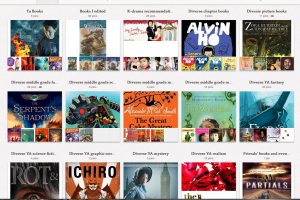Another writer question, the answer for which I think will help more than just one writer. If any of you have questions about what we’re looking for or anything to do with the submission process, please let me know, and I’ll be glad to answer here on the blog (anonymizing your question so it can be generalized).
i was really glad to see Lee and Low’s new imprint. I’m a long time fantasy/sci-fi fan distressed by the cultural sameness of the genre. I have a middle-grade novel that I am currently doing some final revisions for before submission. Because I realize time is valuable commodity for editors, I wanted to get a sense how expansive your fantasy/sci-fi terms were, before I submitted.
My novel is fantasy the way Harlan Ellison’s, short fiction, or Octavia Butler’s Kindred is fantasy. It is a slight conceit used to push the character forward. I do not engage in a discussion of big ideas like Xenogenesis, Foundation etc., nor provide a full-fledged alternative universe like Cordwainer Smith, William Gibson or Anne McCaffery.
So my question is, is that enough? Obviously, you cannot decide on the individual merits of piece without seeing it, but I wanted to be sure I was targeting the appropriate house. Also, Lee and Low’s main imprint requires a chapter by chapter synopsis, but you only suggest a synopsis. May I assume you want a simple one page synopsis (plus first three chapters)?
First, addressing the question of what kind of fantasy we’re looking for:
Fantasy in children’s and YA books is pretty wide open. It can be anything from changing one little thing in the real world (people can fly or be telepathic, etc., or there’s a secret magical cult of ninja vampires, or the Knights Templar secretly fight the undead, unknown to the wider world, or, I don’t know, a girl like Matilda finds out she can teleport things, but maybe nothing bigger than a pencil), to changing a whole world in the future or alternate history (dystopian SF like The Hunger Games or steampunk like Leviathan), to alternate world high fantasy, either through portals (like Harry Potter) or just starting out in that world (like fairy tale retellings).
I’m not sure what you mean by a slight conceit to push the character forward. If you mean something akin to just one little thing changing—such as the ability to time travel, but not control it, as happens for the main character of Kindred—sure! That works, definitely. There are a LOT of middle grade and chapter books based on just such an idea, a small tweak of reality as opposed to huge sweeping differences in worldbuilding.
But I just want to be sure that you’re also familiar with what’s out there right now for children and teens, and not just what was published in the 70s and 80s by some of the best authors on the adult side. If you haven’t already, I suggest going to your local bookstore (or library, but the bookstore is better for seeing more current books all in one place) and looking at the middle grade and YA shelves to get a good idea of how broad the definition of SF/fantasy is in that section. While Octavia Butler’s work is classic and everyone should read them, they’re not what teens are reading right now (at least, not exclusively—of course they’re still reading her, or she wouldn’t be a classic).
Same goes for middle grade readers. Some books will always be classics, but when thinking about writing for a middle grade audience, you want to start from the idea that modern kids will be reading this, so you don’t want to use titles written for adults 30 years ago as your comparison point. As I look at my shelves filled with Shannon Hale’s Goose Girl and Princess Academy, Pseudonymous Bosch’s This Book Is Not Good for You, Brandon Sanderson’s Alcatraz vs. the Evil Librarians, and Adam Rex’s The True Meaning of Smekday, I see a pretty broad range of fantastic and speculative worldbuilding in these titles for middle grade readers and think you’ll probably be okay. David Lubar’s My Rotten Life changes only one thing about the world: a science experiment gone wrong turns Nathan Abercrombie into an accidental zombie. One little tweak in the possibilities of science leads to hilarious adventure.
So: if you’re familiar with what’s out there right now for this audience, you’ll probably get a sense of whether or not your story works for this market. If it also features diversity in its characters and setting, then it works for submitting to Tu. In particular, I want to emphasize that we’d like the main character to be a person of color.
To answer the synopsis question: Yes, a page or two (perhaps four at most for a big, epic tale) is the kind of synopsis I’m asking for with sample chapters. It’s the kind of synopsis that would answer my big-picture plot questions if I liked the first three chapters, to see if you can plot a novel and carry through from a great start. Of course, whether that held up in the full manuscript would then remain to be seen, but it gives me a better idea of whether I’d want to request the full manuscript.

